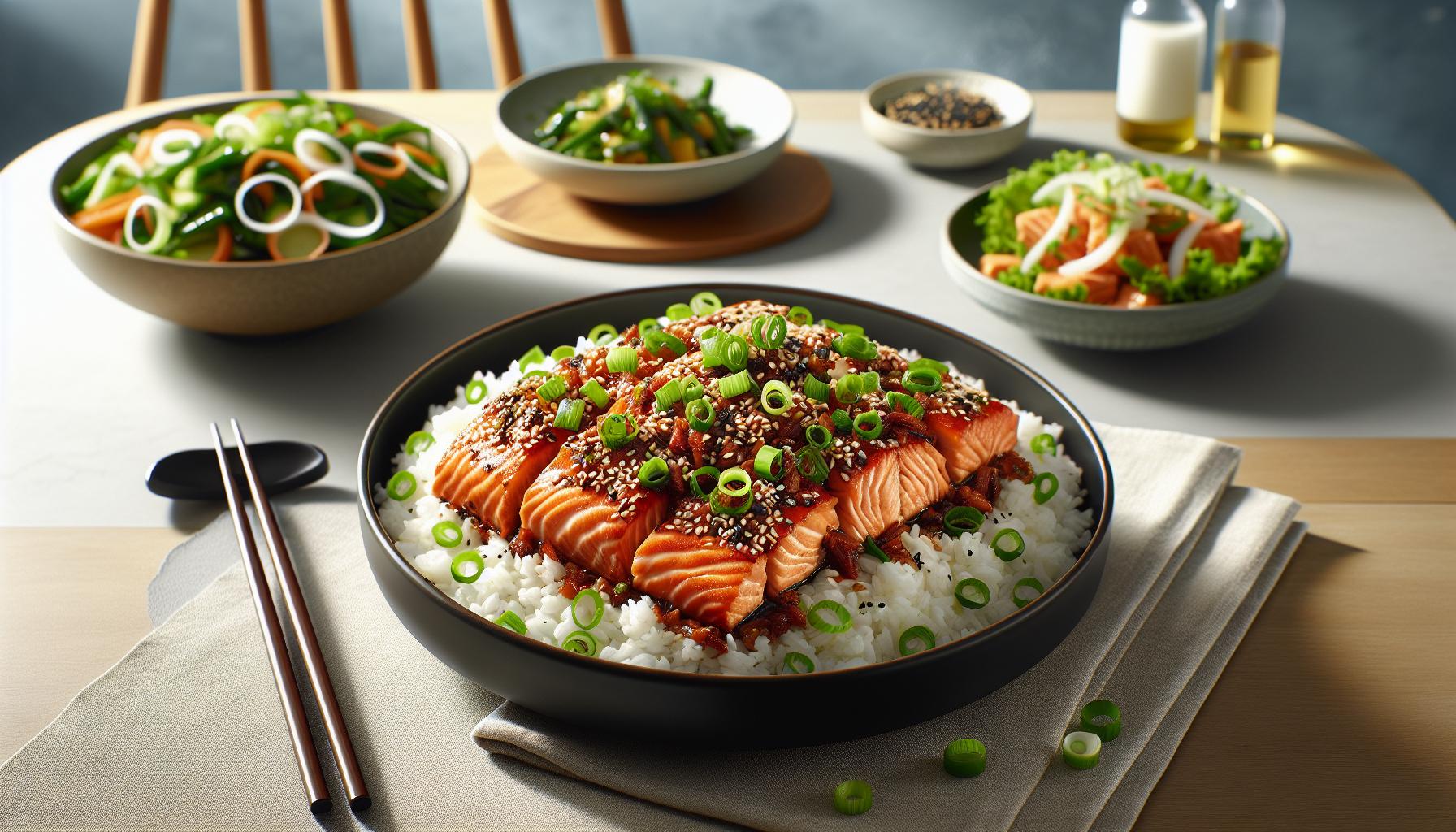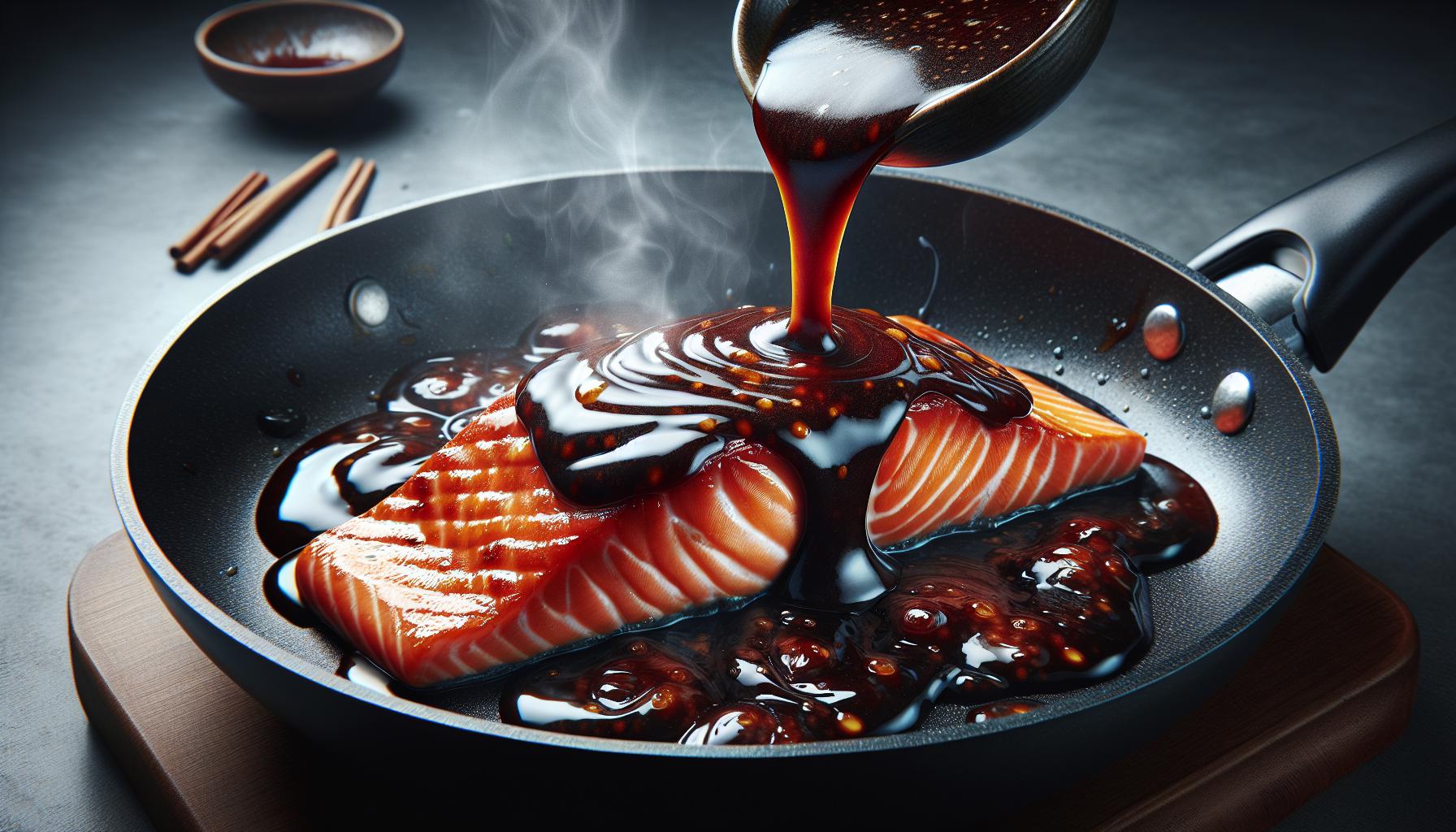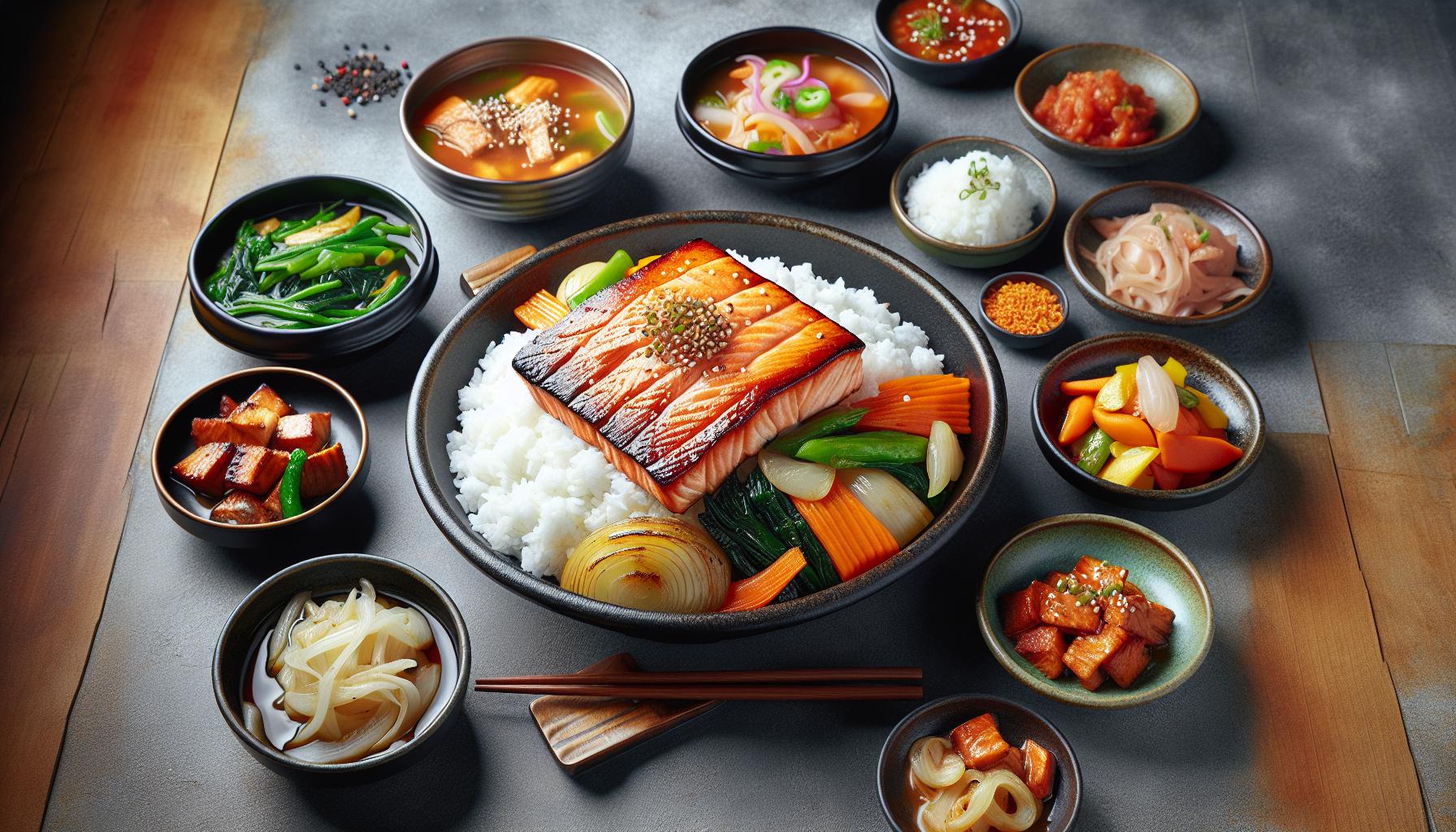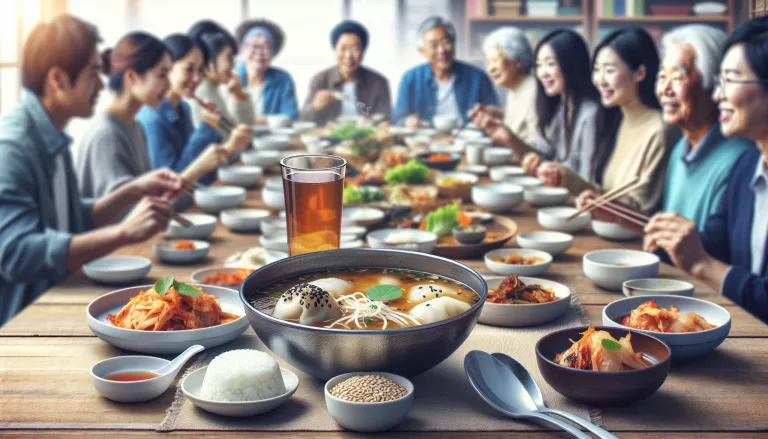Simple Steps to Delicious Homemade Korean Salmon Bulgogi Recipe with Serving Suggestions

Ingredients for Homemade Korean Salmon Bulgogi
Let’s dive deep into the specifics of what you’ll need for this delectable dish.
Primary Input
Salmon, the star of the show, should be your first purchase. Aim for 2 pounds of fresh salmon fillets.
Marinade
To make the marinade for the salmon, stock up on the following:
- ½ cup of soy sauce. Opt for reduced-sodium versions if you’re mindful of salt content.
- A heaping ¼ cup of mirin (rice wine). Can’t source mirin in your area? A dry white wine or a sharp apple cider vinegar could serve as a good alternative.
- 2 tablespoons of honey for that perfect hint of sweetness. Prefer a healthier alternative? Use an equal amount of maple syrup.
- 4 cloves of minced garlic to give that strong, savory punch in your salmon.
- 1 tablespoon of fresh ginger, grated. Fresh ginger makes a notable difference but if you’re out of it, a ¼ teaspoon of dry ground ginger will do.
- 1 tablespoon of sesame oil for that nutty aroma.
- 1 teaspoon of Korean red pepper flakes (Gochugaru). Adjust this as per your preference for heat. An equal amount of crushed red pepper can stand in, but the flavor profile may slightly differ.
It’s best to have the salmon marinate in these ingredients for at least 30 minutes. If you have extra time, letting it sit for two hours would allow the flavors to permeate deeply into the flesh.
Lastly, you’ll need Green onions and sesame seeds as garnish.
Here’s a brief look of all these details in tabular form.
| Ingredient | Quantity (Approximate) | Alternative |
|---|---|---|
| Fresh Salmon Fillets | 2 Pounds | – |
| Soy Sauce | ½ Cup | Reduced-sodium soy sauce |
| Mirin (Rice Wine) | ¼ Cup | Dry white wine or apple cider vinegar |
| Honey | 2 Tablespoons | Maple Syrup |
| Minced Garlic | 4 Cloves | – |
| Fresh Ginger | 1 Tablespoon | Dry ground ginger |
| Sesame Oil |
Step-by-Step Instructions

Now that we’ve got our ingredients lined up, let’s dive into the preparation. Ready? Great, let’s start!
Quicker than you’d believe, step one involves mixing your marinade. Grab your soy sauce, mirin, honey, garlic, ginger, sesame oil, and those punchy Korean red pepper flakes. Whisk them together, ensuring the honey dissolves completely.
In step two, place your fresh salmon fillets in a bowl and pour the marinade over them. Ensure every piece gets a good dousing! Let’s wait for a gastronomical magic to happen – at the very least, leave it to marinate for 30 minutes. If you’ve got time up your sleeve, overnight marination is what will infuse those bold, savory flavors into the salmon even more.
Hitting step three, turn your attention to your cooking equipment. Got a grill? Great! No grill? Don’t worry, a skillet or pan will do the trick nicely. Heat up a little sesame oil till it’s sizzling hot.
Ready to taste the deliciousness you’ve been waiting for? In step four, cook the marinated salmon. Remember, we’re going for that golden caramelized exterior that makes this dish truly mouthwatering.
Step five brings us to the garnishing, the important yet often underrated part of the cooking process. Remember those green onions and sesame seeds mentioned before? Here’s where they move into the limelight.
Feeling innovative? Sprinkle on a tad bit of roasted seaweed or a splash of lime juice to make your bulgogi unique. Tip: A little customization never hurts!
Finally, in step six, serve the salmon hot, with white rice or a fresh salad on the side. Feast your eyes before delving in. Take a bite – you’ve made it.
Let’s not forget the nutritional bonuses you’re getting from this dish. Salmon is known for its rich omega-3 fatty acids, packed with protein and vitamins. Pair that with fiber-filled and vitamin-rich green onions and sesame seeds, you’ve got a solid, nutritious meal.
| Per Serving | |
|---|---|
| Calories | 450 |
| Carbohydrates | 30g |
| Protein | 40g |
| Fat | 20g |
Tips for Marinating the Salmon

Let’s unravel some secrets for the perfect marinade. Remember, it’s not just about soaking your salmon in it, it’s about giving it the TLC it deserves before its grand transformation!
Firstly, let’s talk about time. The ideal marinating period for fish, including salmon fillets, usually falls between 15 minutes to 24 hours. While the minimal marinating time ensures the salmon absorbs the flavors, leaving it for too long might result in a mushy texture due to the acid in marinades. Therefore, you want to find a balance based on your schedule and personal taste.
Second, be sure to evenly coat your salmon with the marinade. You want every bite to be a party in your mouth, don’t you? So take your time to massage the marinade into the salmon fillets, making sure they’re well coated. Consider saving a small portion of the marinade separate for basting during cooking to reintroduce those mouth-watering flavors.
Homemade marinades often allow for a personal touch. For an additional zing, you could add a squeeze of lime or a drop of honey. Trying to keep it low on sodium? Switch the regular soy sauce with low sodium or tamari.
Lastly, something interesting – ever thought of using zesty beer as your marination base? Besides adding depth to the flavor profile, the carbonation also tenderizes the salmon, making it absorb the marinade better.
So there you have it. Some handy tips to take your salmon marinating game up a notch. Remember, excellent marinade treatment promises a superior final product, your Korean Salmon Bulgogi! Visit again as we plunge further into more culinary tips and tricks.
Cooking the Bulgogi

Now that your salmon has soaked up all those fantastic flavors, you’re ready to get cooking. Remember, the journey of preparing your homemade Korean Salmon Bulgogi is just as important as the end result.
The first step is to heat a non-stick pan over medium-high heat. Although you’re not restricted to a non-stick pan, it’s quite handy here. Promotes even cooking and less sticking. A win, right?
Dab off any excess marinade from the salmon fillets. Avoid overcrowding the pan – you don’t want your salmon to steam. Instead aim for that nice, crusty sear.
As your salmon sizzles on the pan, pay attention to its color. The transformation from a vibrant orange hue to a soft pink is one you’d want to watch for. Expect this process to take roughly 3-4 minutes per side.
Cooking times can vary though, based on how thick your fillets are. Since salmon can easily become dry if overcooked, it’s best to err on the side of caution.
Whip up a quick bulgogi sauce while the salmon cooks. Combine soy sauce, brown sugar, sesame oil, garlic and ginger. Feel free to toss in a pinch of red chilli flakes for an extra kick. Stir this up over low heat in a small saucepan.
Once your salmon is cooked on both sides, pour the bulgogi sauce over. Bask in the sizzling sound as the sauce caramelizes, forming a glossy sheen on your salmon. Let this simmer for just a couple of minutes.
Fuel your creativity! Feel free to tweak the base recipe to your liking. Perhaps you’d like to elevate the heat with a generous sprinkle of freshly ground black pepper or and add a dash of lime juice for a refreshing citrusy twist. Experiment – that’s the magic of cooking at home.
Don’t worry too much about getting it perfect. Good food takes time, patience, and practice. As you experiment and learn, you’re crafting your own signature Salmon Bulgogi dish. Just keep at it. Enjoy the journey.
Serving Suggestions

Now that you’ve mastered the art of cooking your very own Korean Salmon Bulgogi, let’s take it a notch higher by exploring different ways to serve it.
Consider serving your bulgogi over a bed of steamed rice. It’s a classic combination that welcomes the rich flavors of this dish. Steamed jasmine rice or brown rice are excellent options. They absorb the Bulogogi sauce quite well and wash down the savory taste of the salmon.
Think about complementing your bulgogi with some freshly cooked vegetables. A quick stir-fry with bell peppers, zucchini, or snap peas adds a delightful crunch and color to your meal. You could also make a quick pickled cucumber and carrot salad for a refreshing break from the bulgogi’s bold flavors.
Digging into a bowl of hot spicy soup could be another enticing way to round off your bulgogi meal. Korean cuisines are well known for their wide variety of soup choices. A bowl of Kimchi-jjigae (Kimchi stew) or Doenjang-jjigae (soybean paste stew) would definitely add a warm touch to your meal.
Don’t forget the Banchan! Banchans are Korean side dishes served along with the main course. Kimchi, beansprouts, and dense omelettes are some popular banchan choices. They can add an extra layer of flavor and texture to your bulgogi feast.
Conclusion
You’ve navigated your way through crafting your homemade Korean Salmon Bulgogi. You’ve mastered the art of marinating, cooking, and even pairing this delicious dish with complementary sides. Now, it’s your turn to bring this culinary adventure to your own kitchen. Remember, the beauty of this recipe lies in its versatility. Whether you’re serving it over a bed of steamed rice, alongside stir-fried veggies, or with a spicy Kimchi-jjigae, your Salmon Bulgogi is sure to impress. Don’t forget the Banchan, those little side dishes that elevate your meal from good to great. So, go ahead, don your apron, and let your culinary creativity run wild. After all, the best meals are those that are personalized to your taste. Here’s to your successful Korean cooking adventure!




